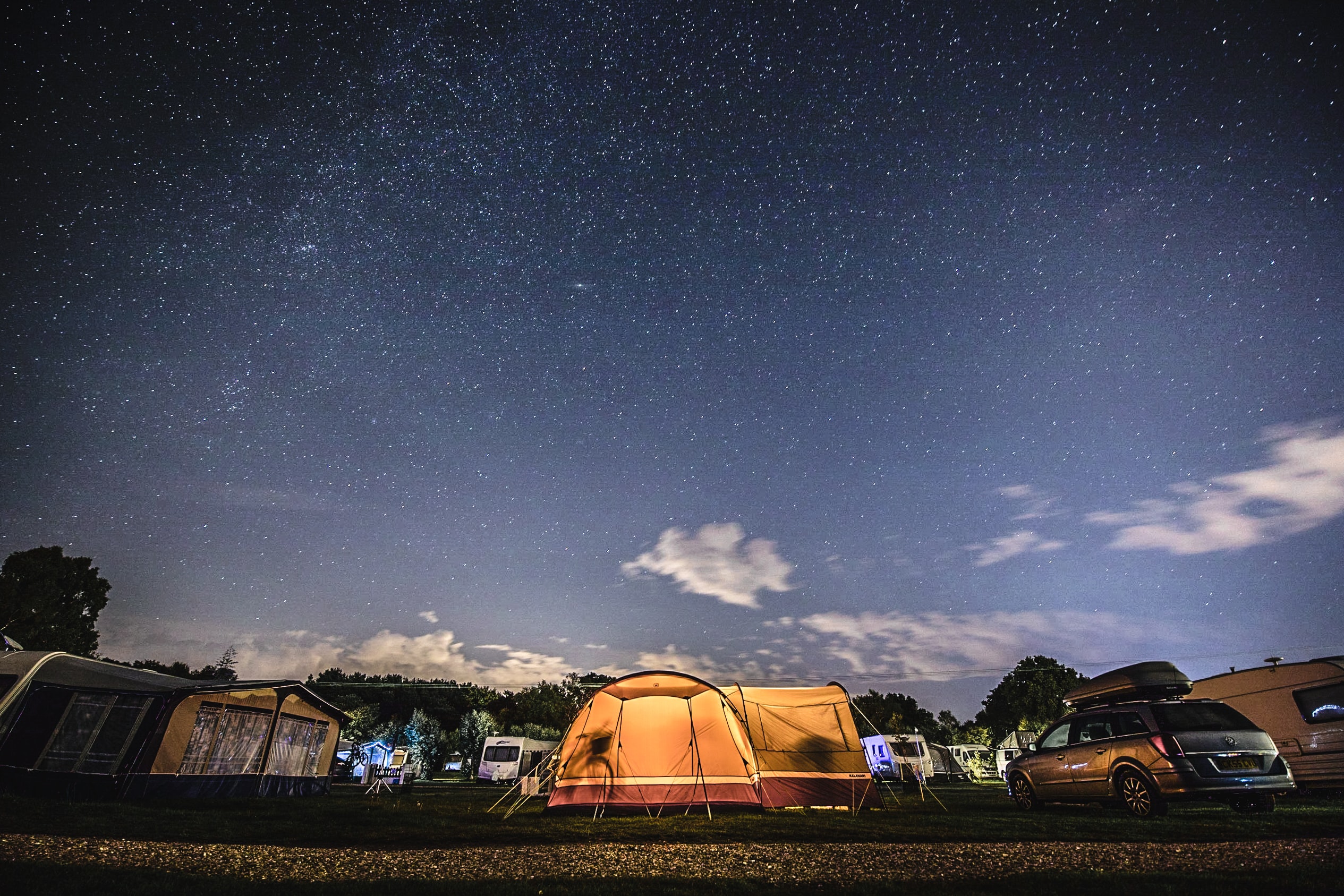
Whoever said camping was a low maintenance vacation was sorely mistaken. (Reader, it was me.) You quite literally have to plan to bring everything you need to survive with you.
With backpack camping, you’re strapping every necessity (your pot and pan; tent and sleeping pad; water bottle and portable stove) to your person. You have to make every inch—and pound—count.
With car camping, space and weight are much less of a concern. However, anyone who has ever packed for an overnight trip knows all too well how extra space in a suitcase beckons for those just-in-case items. So, while you might be tempted to pack items you don’t need because you have the space—like a stack of single-use paper plates versus one reusable plate you have to wash—don’t. Instead, use these tips to plan a sustainable car camping trip. The environment (and your wallet) will thank you, even if it means a bit more work on your part.
1. Avoid single-use anything—and instead bring reusable
Plasticware. Paper plates. A case of bottled water. These are just a few of the single-use items to avoid when you’re crafting your car camping packing list. While it would be easier to skip washing dishes or constantly refilling your reusable water bottle (more on that below), it’s certainly not eco-friendly.
Instead, bring reusable gear and supplies. This includes items you’ve upcycled from your own home. For instance, hang on to that old percolator you recently replaced for brewing coffee on your camping trips. The same goes for mismatched coffee mugs or a blanket that’s seen better days. Don’t toss your household items; give them new life as your camping gear. This saves them from the landfill, and saves you from buying new when you’re only using your camping gear a few times per year.
2. Buy used camping gear
Speaking of new, if you’re new to camping, or testing the waters with new-to-you activities like kayaking or canoeing, don’t go all-in with buying new gear. Instead, head to a neighborhood yard sale or online marketplace to take a gently used tent or kayak off of someone’s hands. Doing so is better for the environment—and you don’t have to feel guilty if you’re not able to use it as often as you’d like (or end up re-selling said gear).
3. Watch out for your water source
Depending on where you plan to camp, you may or may not have access to clean, drinkable water. When in doubt, plan to bring all the water you’ll need for cooking, consuming, and so on, in reusable containers. (And remember to bring reusable water bottles and cups, too.) That way, if you’re at a campground that provides a water source and you run out, you can easily refill containers on-site—avoiding a trip to a store and an impulse purchase of single-use containers.
Planning to go wild camping? Pack a water purification kit to ensure that any new water you procure is clean and safe to drink.
If you’ve chosen a campground with a bath house (lucky you!), remember to keep your showers short to conserve water. Likewise, protect the groundwater table by using biodegradable soaps, shampoos, and detergents. Switching to an environmentally friendly sunscreen helps protect the health of rivers, lakes, and oceans, too.
4. Choose a sustainable site
If you’re camping at a campground, look for one that promotes eco-friendly practices, such as:
- Utilizing green energy sources, like solar shade structures and/or wind turbines to help power the campground’s facilities
- Energy-efficient LED lighting
- Recycling programs
5. Seek out eco-friendly activities
While you’re in the wilderness, be kind to the local ecology with activities that support and promote environmental wellbeing. Skip the motorized boat and opt for a kayak or canoe if you’re camping near a body of water. Going hiking? Remember to leave the trails better than you found them; bring home any trash and stick to the marked trails to protect the area's plant and animal life.
Planning to take a screencation during your camping trip? (There’s no service anyway? I won’t tell.) Going screen-free helps you use less energy because you won’t have to charge your devices as frequently.
6. Shop local
All of that vigorous activity and Vitamin D probably has you feeling peckish. Decrease the carbon footprint of what you eat during your camping trip by shopping local—ideally ahead of your trip, but also while you’re camping. Check out a local farmer’s market for freshly grown and locally made items or head to an orchard for seasonal you-pick produce.
7. Dispose of your biodegradable refuse responsibly
While you’re camping, you may be tempted to toss biodegradable food scraps, like apple cores or peach pits, into the woods. This is a hard no. Not only will this likely attract animals to your campsite, non-native plants are a threat to local ecology.
Collect your food scraps to bring home and compost (which, when done properly, kills the seeds), or at the very least, throw them in a proper trash receptacle.
8. Make sure your car is ready for adventure
Like a sustainable road trip, limit your car’s impact on the environment during your camping trip.
Here are a few tips:
- Get road-ready. A well-maintained vehicle not only saves on fuel consumption and is friendlier to the environment, it’s safer to drive, too.
- Carpool, when possible. The fewer vehicles you take, the better.
- Drive slow. According to the U.S. Environmental Protection Agency and Department of Energy’s Fuel Economy Guide, your vehicle’s fuel efficiency decreases by 7% for every five miles per hour you drive over 60 MPH.
Once you reach your destination, try to park the car in one spot for the duration of your camping trip. Doing so helps to limit your fuel consumption—and the overall environmental impact of your camping adventure.
Finally, remember to sustain your own safety and wellbeing, too. As with any vacation—but definitely a camping trip—be sure to share your travel plans with your Inner Circle (a TripIt Pro feature). This way, your travel buddies, as well as anyone at home, can access your trip details and be in the know about your whereabouts in case they need to reach you.

